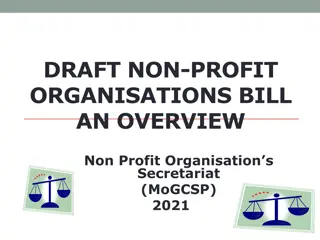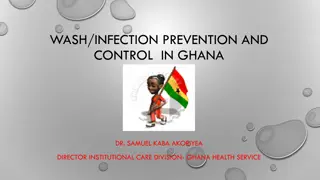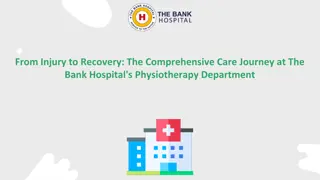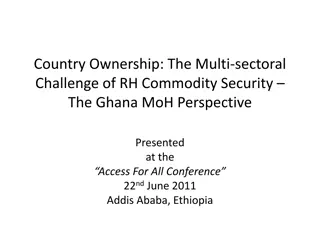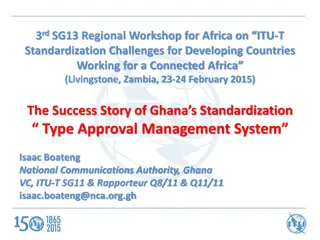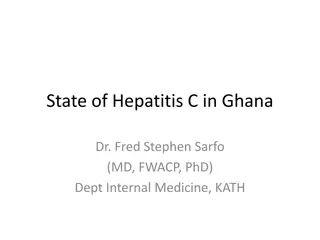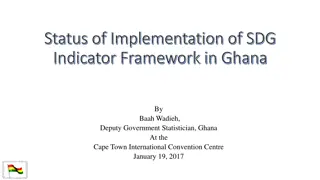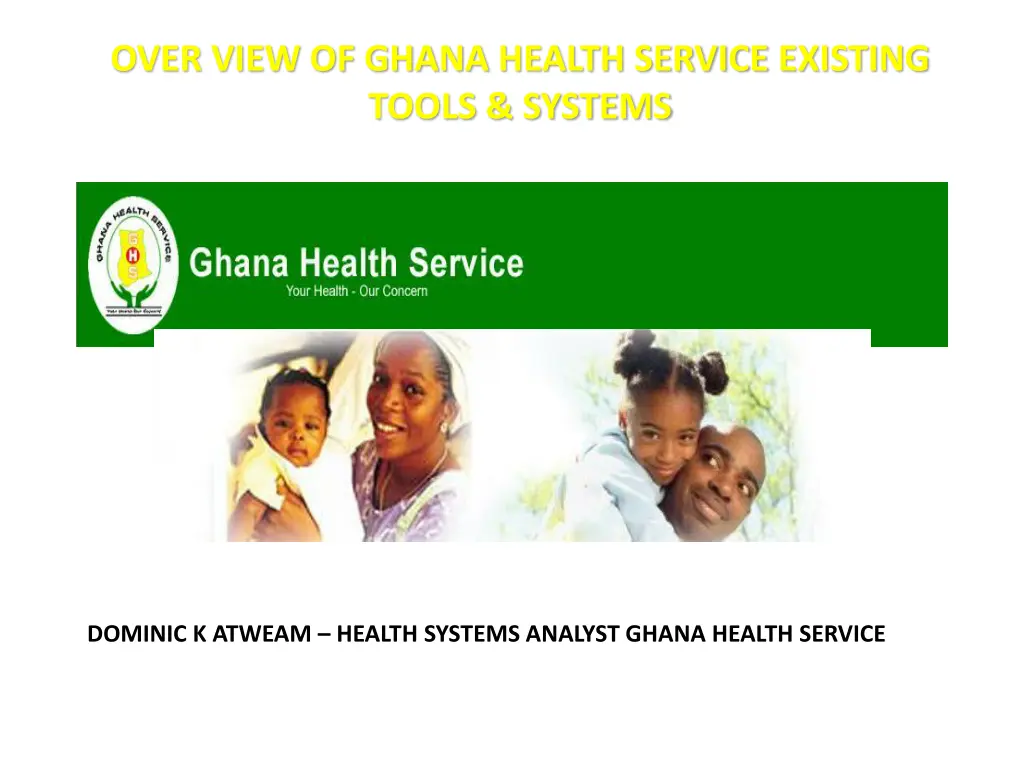
Optimizing Ghana Health Service Data Management
Enhance Ghana Health Service data management by transitioning from manual data aggregation to real-time online data collection and analysis using DHIMS2. Address challenges of accuracy, completeness, and timeliness for more efficient health service delivery.
Download Presentation

Please find below an Image/Link to download the presentation.
The content on the website is provided AS IS for your information and personal use only. It may not be sold, licensed, or shared on other websites without obtaining consent from the author. If you encounter any issues during the download, it is possible that the publisher has removed the file from their server.
You are allowed to download the files provided on this website for personal or commercial use, subject to the condition that they are used lawfully. All files are the property of their respective owners.
The content on the website is provided AS IS for your information and personal use only. It may not be sold, licensed, or shared on other websites without obtaining consent from the author.
E N D
Presentation Transcript
OVER VIEW OF GHANA HEALTH SERVICE EXISTING TOOLS & SYSTEMS DOMINIC K ATWEAM HEALTH SYSTEMS ANALYST GHANA HEALTH SERVICE
BACKGROUND Ghana Health Service (GHS) works with a structured decentralized health delivery from National Regional District Sub-district Facility (Community These levels and structure has been adopted to make DHIMS2 a very meaningful resource to the GHS. DHIMS2 is accessible in all 216 districts and is being used by health facilities and district health directorates to collect, collate, transmit and analyze routine health service data DHIMS2 is built on the DHIS2 platform
BACKGROUND At the end of each month, trained staff in all health facilities and district health directorates manually summarize Health Service Data example Child and Maternal Health Records data into the monthly reporting forms (example, Monthly EPI form) by tallying and aggregating for input into DHIMS2 at the facility level or district level and sub district for a facility.
BACKGROUND Data is immediately uploaded and made available online in the DHIMS as real- time data. Visible to DHIMS2 registered health service managers at all levels in the Health Sector BUT accuracy, completeness, consistency and timeliness of the data has always been questioned! Secondly primary data collection tools at the Health Facilities are usually service registers which capture transactional individual clients data These registers are not available to the district, regional level or national level. The district level keeps data in electronic form in the DHIMS2, which is only aggregated data, making detailed analysis on Child and Maternal Health Service limited.
Situation Analysis2 Post DHIMS2 The DHIMS2 at present takes mainly aggregated data, with the exception of inpatients data that is captured individually. This hampers any rigorous data analysis outside the predefined fields in the summary forms. Continuous proliferation of data collection forms. Driven by the monitoring requirements of development partners and Global Health Funds . Health workers in facilities in the district spend 5-7 days every month filling out this numerous Duplication of collection of various service data leading to Multiple reporting and increase transposition errors resulting in different data at different level on the same indicator - Data overlaps among datasets ( service forms )
MONTHLY NUTRITION REPORT MONTHLY VACCINATION REPORT MONTHLY IDSR OPD MORBIDITY CAUSES OF DEATH STATEMENT OF OPD DATASETS FORM A FORM C IP MORBIDITY Hb screening Births & birthweight Active MTMSG MONTHLY NUTRITION REPORT Growth monitoring Vit. A suppl. Vit. A stock & coverage PP Vit. A All antigens Vit. A coverage MONTHLY VACCINATION REPORT TT2+ AFP Measles NNT Diarrhoea Meningitis Pneumonia Yellow Fever AFP Measles NNT Diarrhoea Meningitis Pneumonia Yellow Fever Yellow Fever AFP Measles NNT Diarrhoea Meningitis Pneumonia WEEKLY IDSR All morbidity cases All malaria cases by age category & by sex Malaria in pregnancy All malaria admissions by age categories All malaria deaths by age categories Malaria in Pregnancy MALARIA CRF
MONTHLY NUTRITION REPORT STATEMENT OF OPD DATASETS FORM A MALARIA CRF Total malaria cases Malaria cases tested Malaria cases positive OP MORBIDITY Total OPD attendance Positive malaria MALARIA ACTs ANC registrants ANC attendance IPT 1-3 ITN use Hb screening MALARIA MATERNITY REPORT Deliveries CMAM report Deliveries with atleast 2 IPT Suppl. Feeding report Birthweights NMCCSP report Stillbirths & neonatal deaths ANC registrants Pre counseled PMTCT # Tested # positive Mother/baby on ARV
CONSISTENCY OF TT2+ DATA IN VACCINATION REPORT & FORM A 110% 105% %CONSISTENCY 100% 95% 90% 85% May-12 May-13 Apr-12 Nov-12 Dec-12 Apr-13 Jul-12 Sep-12 Feb-13 Jul-13 Aug-12 Oct-12 Mar-13 Aug-13 Jun-12 Jun-13 Jan-13
%ACCURACY OF IPT 3 DATA BY A DISTRICT %accuracy Target 115% DQA activities 110% %IPT 3 DOSES 105% 100% 95% 90% 85% Months
BACKGROUND For this reasons it has become necessary to develop client based individual CHILD AND MATERNAL HEALTH RECORDS case management record system Directed by DG of GHS on advice from The ICT committee not to develop another silo The DHIMS2 e-TRACKER to collect, manage and analyze transactional case based records at the community level.
WHAT IS THE DHIMS2 eTRACKER The GHS DHIMS2 e-Tracker (open sources) replaces the GHS eRegister (sole proprietary and licensed ) The system will allow service providers for the Child and Maternal Health program to collect, manage and analyse transactional, case-based data records. It will store information about individuals and track these persons over time using a flexible set of identifiers. The system can capture information about anonymous events and cases as well. The tracker can let you send SMS-reminders, Track missed appointments generate visit schedules. You can create dynamic reports based on cases and generate on- the-fly statistical reports. The Child Health programme for instance and their users can easily create statistics and summaries on participation and completion. The e-Tracker is an extension of the DHIMS 2 platform and supports management, data collection, and analysis of transactional or disaggregated data. The system share the same design concepts as the overall DHIMS2 Common for all the use cases is that the transactional data can be easily aggregated and fed into the main aggregated data warehouse in the same DHIMS2 system.
GHS HIMS STRATEGY Data Transactional Data Data Warehousing and Reporting Integration Clinical Information Systems GHS- Integration Tools DHIMS2 eTracker/CHO messaging Other Systems
Integrated architecture of interoperable systems Integrated architecture of interoperable systems and infrastructures (paper, computers, internet, mobiles telephones Replicated at each administrative level: National Regional District Reports, GIS, Pivot, Graphs Data from/to mobile phones etc Data capture from Paper reports Data Warehouse Import e data Household Tracking Monthly summary Reports Export e summary data Medical Records Logistics MIS Human Resource Records Open MRS Open LMIS Telephone iHRIS Register pregnant women and immunization
Journey so far- Integration Key Implementation Activities Purpose How Set up of GHS ICT committee- last year System documentation of all eHealth initiatives within the Health Service For GHS to proper co o ordinate , manage and provide proper governance of all ehealth initiatives. Sustainability Ownership Monthly meetings. Reviews Documentation and maping of all ehealth efforts in Ghana. Development of GHS HIMS strategic direction (3 Page) Guidelines & Policies Data security Define the interoperability parameters clearly using the DHIS2 platform as the standard conforming to the GHS EA Technical boot camp with all stakeholders mHealth Implementation Guidelines mHealth project aiming at being sustainable should be possible to be integrated into business process of the health sector. It should aim at bringing efficiency to what is already being done by the Health Sector Implementers of mHealth should be informed by the Mobile Handheld Policy and Guidelines document of the Ghana Health Service
Journey so far- Integration Key Implementation Activities Purpose * Possible reduction of 54 data sets in DHIMS2 How National data sets rationalization meeting with all programmes and divisions heads. To identify primary data forms based on their core mandate and what other forms are secondary forms. Identify reporting forms that can be generated as a report. Reduce multiple data elements and indicators on data sets . Report forms which should be moved in part or full and used as a standard reports and with part maintained for data entry. Discuss and introduce time frame for coordinated introduction of new variables and reporting forms to address the frequent stock-outs of data reporting forms and registers 2- Pre technical meeting to identify key areas and overlaps 5 days meeting with all programmes and divisional heads involved Institutional Care Div. Public Health Div. Family Health Div. Base Line data
Journey so far- Integration Key Implementation Activities Purpose How Blue print for DHIMS2 system integration with other systems ( deliverable within the GHS EA) To allow synchronisation of org units, facility codes , data sets and data elements and indicators- to be published as a subset of National Health Data Dictionary Technical boot camps with GHS technical team and developers of GHS-eRegister and Motech Development of National Health Data Dictionary-NHDD To provides a reference point for information standards to support health care activities within the GHS . It has been developed and still being developed for everyone who is actively involved in the collection of data and the management of information in the GHS-MOH Lead by NHIP- worked with all MOH agencies 1st version to be published before the end of this year.
DVD-MT integration into DHIMS2 Short Term Support district to be able to import the monthly EPI data FROM DHIMS2 for DVD-MT to generate their color code indicators Long Term (WHO, HMN , HISP, DHIS2 Community) Work with the HISP and DHIS2 community to integrate the analysis module of DVD-MT in the data visualiser module of DHIS2.. Areas DVD-MT DHIMS2- (DHIS2 PALTFORM) Captures EPI monthly output data from DHIMS2 at the regional level Collects all Health Service Aggregated monthly data including EPI for DVD-MT at the district level (216 districts and 1068 sub districts )and below Web based and real time Data protected. Data capture
Overview of Existing System eHealth efforts Key Service Area Tools Being Used Status DHIMS2 All Health Service aggregated data and In Patient line listing (54 data sets) Web based, personal computers Tablets, smart phones, mobile internet modems procured for all districts. Two regions have procured modems for all their sub districts Deployed in all 216 districts, 1028 sub districts & 5000+ facilities . Data is entered at facility level or at the sub district for a facility level . GHS eTracker Individual patient data on Immunization, Growth Promomtion and MCH- one unique system generated ID linked to all services of mother and child Clouds Web based, personal computers Tablets, smart phones, mobile internet modems procured for all districts. Two regions have procured modems for all their sub districts Deployed in 1 District
Overview of Existing System eHealth efforts Key Service Area Tools Used Status Maternal and child health services in Ghana . (CHPS zone, Health Centre s)) Motech Grameen found. & GHS Simple mobile phone Nursing applications Client application In 5 Districts There is a transition team in place to transition Motech Messaging and ID system to GHS eBlood bank On-line visibility of blood types stock levels to all facilitities in the regio nal capital Web based, Apps on clients phones Personal computers Smart phones Evaluation to be done this year to guide scale up to all blood collecting and stroing facilities. Early Warning Systems Stocks levels of familiy planning and some HIV AIDs comodities Web base and users (health workers ) mobile phones All coastal regions in Ghana- now being deployed to other regions ..
Lessons learnt There is a big difference from piloting and country scale up. sustainability , incentives make pilot work but cannot be sustained in scale ups We cannot just depend on one system for everything. community level data , clinical care data , stocks levels , finance , HR Combining both HIM duties and Server management HIO being custodian off all data at the districts Addressing donor reporting needs and local reporting needs as well- Silos of organisations wanting to do the same thing
Lessons learnt Working with Vendors who don't understand the health service delivery system, difficult in resolving system issues that affects service delivery. Managers understanding of service reporting forms .. the idea that I need to develop and to see my programme forms to collect what I need but not looking at if what the programmes needs is already being collected by other programmes.. Involving Key stake holders always very important in any decision making especially end users
Factors Hindering and enabling Progress Hindering factors (Challenges ) Enabling factors Functional roles of ICT and HIO Managing the change to improve the human factor ICT Infrastructure and governance if not fully implemented Integrated capacity building across all levels National , Regions , Districts and sub districts Skepticism ( you cant roll out nationwide? It will fail? Support from senior managers- the Buy inn factor Internet connectivity in remote areas allowing facilities and sub districts to sending their data to the district for data to be entered for them Involvement of key stake holders in HIMS decision making especially end users Managers understanding of report forms Available funding and access Sole reliance on DHIO on health service data
Good customers of data and usage of the systems for decision making? When routine health service data is visible, easily available and accessible on a common platform for all managers, there are constructive critiques on what the typical trends of specific indicators should look like versus what anomalies are being recorded to prompt further inquiry. This leads to continuous discussions on how to improve upon reporting rates, data completeness, accuracy and internal consistencies of the routine health service data. This also helps to draw the true pattern of service utilization against the knowledge of the interventions that are being put into the health care service delivery system across the various districts. Service providers should only collect and report on data on the service they offer. Age continuum reports for MDG 4, 5, 6 Monthly report summaries GHS HQ Regional focal persons Managers and directors last log on audit reports Districts and regional performance review Districts and regional data quality teams
. GHS Business , Applications, Data & Technical Architecture.


